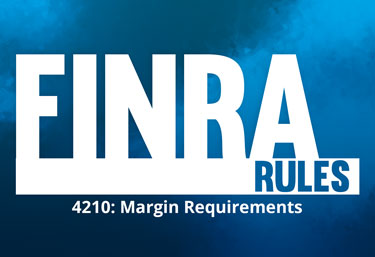Understanding FINRA Rule 4210
Do you have a margin account with your brokerage firm? If so, you should be aware of the rules and regulations that govern the use of your account.
 A margin account is one in which a broker-dealer allows an investor to borrow money in order to purchase securities.
A margin account is one in which a broker-dealer allows an investor to borrow money in order to purchase securities.
Based on federal securities laws and FINRA regulations, there are strict rules governing the terms under which brokerage firms can offer investors credit to make securities transactions.
One of the core rules is Federal Reserve Board Regulation T. This regulation limits brokers to lending up to 50 percent of the initial purchase price for securities.
FINRA has supplemented this regulation by enacting key rules, including Rule 4210, which puts ‘maintenance’ margin requirements on many investor accounts.
At Sonn Law Group, our top-rated investment fraud lawyers are committed to protecting investor rights. If you are using margin accounts to purchase securities, we want to ensure that you fully understand the risks. If you lost money trading on margin, and you believe that your broker misled you are gave you poor advice, please do not hesitate to contact our legal team for assistance.
Your Guide to FINRA Rule 4210 (Margin Requirements)
Initial Margin Requirements
For the vast majority of securities investors, their initial margin requirements are governed by Federal Reserve Board Regulation T. As a general rule, Regulation T requires investors to put down as at least 50 percent of the initial purchase price of securities in cash. For example, if you want to purchase $10,000 worth of a specific stock, you will likely be required to put down at least $5,000 in cash. Your broker (if they choose) can lend you the remaining $5,000 in margin.
To be clear, 50 percent is merely a minimum requirement for standard securities transactions. In certain situations, securities transactions may have a larger initial margin requirement, and a greater percentage of the initial purchase price will be required to be in cash. Brokerage firms have a legal duty to comply with initial margin requirements.
Maintenance Margin Requirements
FINRA Rule 4210 also places maintenance margin requirements on most investor brokerage accounts. As a general rule, an investor’s equity in an account should never be less than 25 percent of the market value of the total securities held in the account. If changes in prices or market conditions result in a customer’s equity falling below 25 percent, they will likely be required to take action.
Typically, this means that the brokerage firm will require the customer to deposit additional equity into the account (this is commonly known as a ‘margin call’). If the customer does not put enough equity to meet the minimum standard, or to meet the broker’s internal standard, then a portion of their securities holdings may need to be liquidated by the broker to bring the account back into compliance with the maintenance margin requirements.
Understanding a Margin Call Through an Example
Assume that an investor wanted to make a substantial purchase of securities in a hot new biotech company that trades under the symbol ‘Stock A’’. This investor has $10,000 to invest, and wants to maximize their holdings. Currently, each share of Stock A is valued at $100.
Under Federal Reserve Board Regulation T, which requires a minimum of 50 percent equity in the initial purchase, a brokerage firm could potentially allow this investor to purchase 200 shares ($20,000). 100 shares would be covered by the cash ($10,000), and the other 100 shares would be covered by the margin ($10,000).
Unfortunately, this trade goes poorly and the stock price plummets. In short order, it falls to only $65 per share. The total value of this investor’s holdings Stock A is now at $13,000. However, the investor still owes $10,000 to the brokerage firm. This means that the investor only has $3,000 worth of equity in a transaction worth $13,000. That translates to equity of just 23.07 percent.
Under FINRA Rule 4210, all broker-dealers are required to set their maintenance margin requirement at 25 percent or higher. This means that a margin call would be required. The investor would need to deposit enough money to bring their equity up from 23.07 percent to 25 percent. In this example, the margin call would be $250. If they investor failed to do so, the brokerage firm would be obligated to liquidate a portion of the account.
Additional Margin Requirements
The Financial Industry Regulatory Authority has enacted additional Rule 4210 requirements. Currently, these new rules are set to become effective as of June 25th, 2018. Under the new regulations, which were initially adopted in 2016 and were delayed to ensure that brokers could update their systems and policies to satisfy the requirements, more transactions will be covered by Rule 4210. Specifically, the following types of transactions will be considered to be Covered Agency Transactions for the purposes of FINRA’s margin requirement regulations:
- To Be Announced (TBA) transactions;
- Adjustable rate mortgage (ARM) transactions:
- Specified Pool Transactions; and
- Collateralized Mortgage Obligations (CMOs).
As this is a sharp regulatory change, brokerage firms will be required to collect additional margin from certain counterparties. Some investors, particularly institutional investors, may be affected by the regulatory changes. Most notably, the new rule gives broker-dealers increased ability to force the liquidation of holdings if their counterparties fail to post sufficient margin as is required by FINRA regulations.
Contact Our FINRA Arbitration Attorneys Today
At Sonn Law Group, we provide high-quality legal representation to investors nationwide. If you sustained losses because of an investment made on margin, and you believe that your broker was negligent, we are interested in speaking to you. Our legal team will help you fight for the full and fair financial recovery that you deserve.
From our main office in South Florida, we represent investors throughout the United States. To get a free claim evaluation, please do not hesitate to contact our law firm today. Our attorneys do not get paid unless we win your case.
CONTACT US FOR A FREE CONSULTATION
Se Habla Español
Contact our office today to discuss your case. You can reach us by phone at 844-689-5754 or via e-mail. To send us an e-mail, simply complete and submit the online form below.

